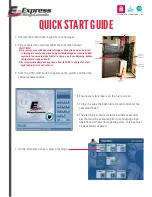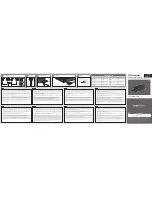
SD16A Instruction Manual
2-5. Terminal arrangement
Note
Do not connect other than the specified input
type to terminal.
11
1
12
2
13
3
14
4
15
5
16
6
17
7
18
8
19
9
20
10
11 12 13
COM AL1 AL2
SG
SG
SD
RS-232C
RS-485
RD
Com
15 16 17
19
18
Power supply
100
~
240V AC
50/60Hz
L
N
L
N
1
2
3
24V
AC/DC
1
2
3
Inputs
TC
6
7
6
6
7
RTD
Voltage (V)
Voltage (mV)
Current (mA)
A
B
B
6
9
7
5
6
7
5
7
19
18
3. Names and functions for front panel
3-1. Names
Front panel
3-2. Functions
[1] Monitoring LEDs
•
AL1 (Alarm 1) output monitoring LED (red)
The LED lights when the assigned alarm is ON.
•
AL2 (Alarm 2) output monitoring LED (red)
The LED lights when the assigned alarm is ON.
•
SET (parameter setting) monitoring LED (green)
The LED lights when the screen displayed is not the basic screen (0-0).
•
COM (communication) monitoring LED (green)
The LED lights when the communication mode is on remote control.
[2] LED display for measured value (red)
•
The current PV value is displayed on the basic screen (0-0).
•
The type of parameters is displayed on each parameter display screen.
•
The set value is displayed on each parameter setting screen.
[3] Key switches
Parameter key
•
On a display screen, shifts the screen to the next.
•
Switches from Mode 0 screen group/Mode 1 screen
group to Mode 1 screen group/Mode 0 screen group.
By pressing this key for two seconds or longer on
screen 0-0 or screen 1-0, shifts to the screen 1-0 or to
the screen 0-0 respectively.
Down key
•
On a setting screen, decrements the value. The last
digit decimal point blinks until the value is registered by
pressing the Entry key.
Up key
•
On a setting screen, increments the value. The last digit
decimal point blinks until the value is registered by
pressing the Entry key.
Entry key
•
On a setting screen, registers the value that is modified
by the Up/Down key. The last digit of the decimal point
blinks until this registration by pressing the Entry key.
•
Shifts between a display screen and the setting screen.
In this case, the light of the last digit of decimal point
goes out.
4. Measuring range code table
Input type
Code
Measuring range
(°C)
Measuring range
(°F)
Note
B
01
0 ~ 1800
0 ~ 3300
Note 2
R
02
0 ~ 1700
0 ~ 3100
S
03
0 ~ 1700
0 ~ 3100
04
-199.9 ~ 800.0
-300 ~ 1500
K
05
0 ~ 1200
0 ~ 2200
E
06
0 ~ 700
0 ~ 1300
J
07
0 ~ 600
0 ~ 1100
T
08
-199.9 ~ 300.0
-300 ~ 600
Note 3
N
09
0 ~ 1300
0 ~ 2300
U
10
-199.9 ~ 300.0
-300 ~ 600
Note 3
L
11
0 ~ 600
0 ~ 1100
Thermocouple
WRe5-26
12
0 ~ 2300
0 ~ 4200
31
-199.9 ~ 600.0
-300 ~ 1100
Note 4
Pt
32
-100.0 ~ 100.0
-150.0 ~ 200.0
33
-199.9 ~ 500.0
-300 ~ 1000
Note 4
R.T
.D
JPt
34
-100.0 ~ 100.0
-150.0 ~ 200.0
0 ~ 10mV
71
0 ~ 5V
81
1 ~ 5V
82
Univers
a
l Input (Note 1)
Vo
lt
a
g
e
0 ~ 10V
83
Current
4 ~ 20mA
95
0.0 ~ 100.0 Scaling available
Scaling range : -1999 ~ 9999 Unit
Span : 10 ~ 10000 Unit
Note 1
In case universal input type is selected, K (Code 05, 0 ~ 1200°C) is set at
factory default.
Note 2
The accuracy of 400°C or below of thermocouple B is ±5%FS.
Note 3
The accuracy of thermocouple T or U is ±0.5%FS at above -100°C and
0°C or below, and ±1%FS at -100°C or below.
Note 4
In case of Pt (Code 31) or JPt (Code 33), scale over occurs at -240.0°C
(-400°F).
[1] Monitoring LEDs
[2] LED display
for measured value
[3] Key switches
5. Error messages
One of the following error messages is displayed on the basic screen (0-0):
When the thermocouple or A of R.T.D. is burnt out. Also
indicated when the PV value exceeds the higher-limit of
the measuring range by about 10%
When the B of R.T.D. (terminal No.7) is burnt out. When
the PV value is below the lower-limit of the measuring
range by about 10%, for such a reason as the reverse
polarity of the input wiring type.
When the cold junction (CJ) is abnormal on the higher
side in the thermocouple input.
When the cold junction (CJ) is abnormal on the lower
side in the thermocouple input.
When the B of the R.T.D. (terminal No.9) is burnt out, or
two or more wires of A, B, B are broken.
3


























